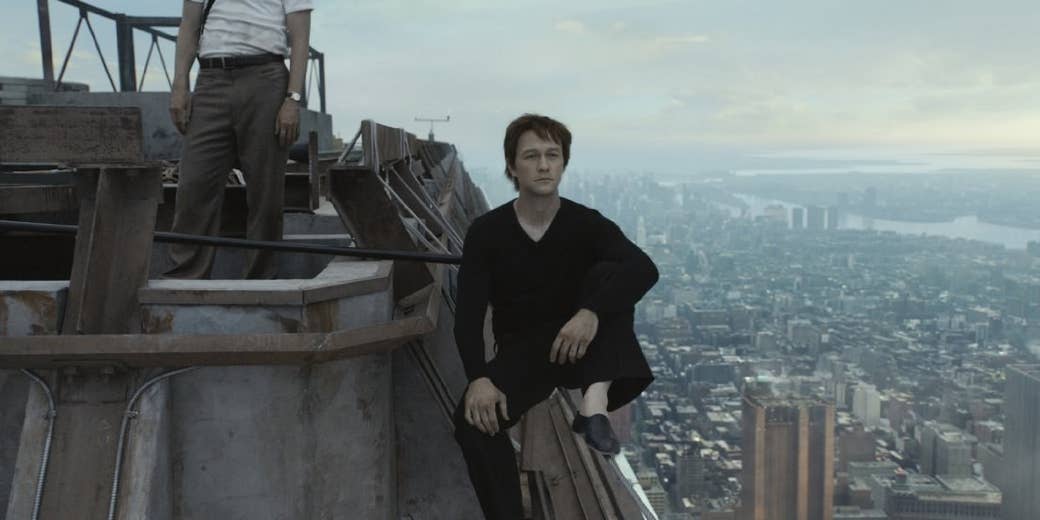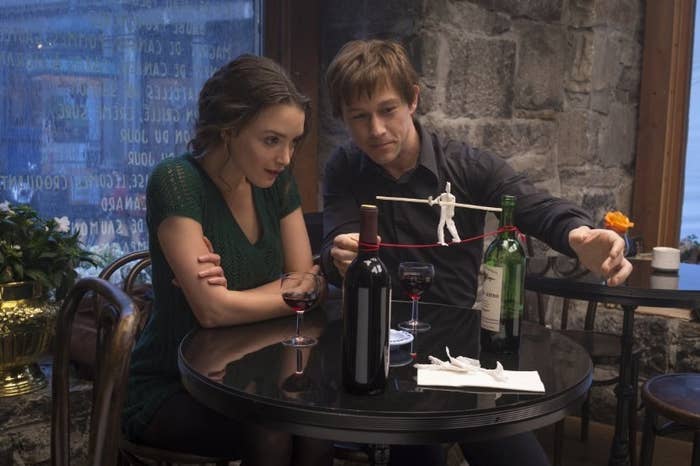
It's a joy to see a movie in the theater. It's an irreplaceable pleasure to lose yourself there in the dark, to surrender your attention to something completely, to become part of a fleeting community made up of you and everyone else in that room for the span of 100 minutes or so, united in what you're viewing together. Seeing something projected on a big screen is great...but we watch films on screens of all sizes these days, from mammoth HDTVs to (gulp) iPhones, and honestly, plenty of them aren't any worse when they're scaled down.
Not The Walk, though.
The new movie directed by Robert Zemeckis (of the Back to the Future trilogy, Forrest Gump, and more recently Flight) and starring Joseph Gordon-Levitt as tightrope walker Philippe Petit is a kamikaze testament to the theatrical experience. There is no point to seeing it at home. Its best stretch, when Petit finally steps out onto the wire he and his friends have illicitly strung between the two towers of the World Trade Center, uses 3D and the field of vision–filling expanse of a theater (or an IMAX) screen in a way you actually feel in your viscera.
It literally has the power to make the vertigo-prone vomit, which is incontestable and endearingly gross proof of just how effective its recreation of dizzying heights is. It's a sequence that feels innovative and new in its filmmaking and its use of a technology that's otherwise mostly been thrown in to beef up ticket prices. It's a viewing experience that, even with one of those 3D TVs that are failing to catch on, you couldn't re-create at home.

And as if for maximum contrast, the parts of The Walk that precede the actual walk in question are numbingly flat. Petit, whose 1974 WTC stunt was previously chronicled in the Oscar-winning documentary Man on Wire, is such a self-styled character — a big, boisterous personality — that turning him into an actual movie character stymies Zemeckis and his co-writer Christopher Browne. Petit's a man who carried out this one glorious, dangerous, ridiculous feat, this sublime stunt, and in committing itself to a biopic format that places Philippe in the torch of the Statue of Liberty to narrate and starts back at his childhood in France, The Walk just emphasizes how unnecessary backstory is here.
No one would ever ask for more Philippe. He's a pixie with a Pepe Le Pew accent who likes to ride around on a unicycle while wearing a top hat and who speaks in pronouncements like, "People ask me, 'Why do you risk death?' For me, this is life." Philippe even insists on having a conversation with fellow busker and eventual girlfriend Annie (Charlotte Le Bon) in mime. As a role, he highlights Gordon-Levitt's most unfortunately theatrical tendencies, his tendencies to strain to charm and entertain.
Philippe's forceful whimsy can't be separated from his petty tyranny in commanding his "accomplices" (played by Clément Sibony, James Badge Dale, and Ben Schwartz, among others) to help him fulfill his dream of breaking into the Twin Towers before construction is finalized. He is, like a lot of ambitious artists, a narcissist who manages to convince others that his vision is also their vision, though it's of course just him out there risking his life on the wire for the spotlight.
Man on Wire showed us that after Petit achieved his walk, and after he was released by the police, he went home not to the girlfriend who'd been with him all the way but with a random woman who wanted to express her appreciation for his stunt by having sex with him. In the doc, it felt like a tiny fall from grace, the shift from this collaborative, selfless act of daring to one of unapologetic vainglory. It's not a development that The Walk, with its cuddlier Philippe, includes, but it still struggles to reconcile the fanciful purity of what the man wants to do with the calculated showmanship and the exacting demands on others that the act entailed — and with, for instance, the moment Philippe seems ready to assault a stranger who might interfere with what he's about to do.
It's not that everything that happens in The Walk after Philippe finally gets to the rooftop makes up for everything that comes before, but it does render it unnecessary. There on the roof, as Philippe and his friends finish up their performance-prep-as-heist, Zemeckis, a director always interested in what advancing technology means for filmmaking, gets to indulge in visuals that push 3D to some sweaty-palmed limits. If Gravity used 3D to emphasize the vertiginous centerlessness of orbit, The Walk uses it to emphasize distance as well as the fact that there is some very solid ground below. When the camera moves over Philippe and shows us the ground yawning beneath his feet, the sense of space it creates is astounding, and the film teases out the details of Philippe's walk, finding 100-stories-up suspense in everything from a misplaced stabilizing bracket to a menacing seagull.
Computer-generated imagery threatens to render us blasé to the most elaborate of set pieces by making everything possible, but The Walk turns what is a relatively straightforward act — albeit a scarily placed one — into something stunning by restoring a sense of physicality to what's happening onscreen. Gordon-Levitt wasn't really high above the earth, but the movie puts us up there with majestic believability. Even a heavy-handed final nod to 9/11, after an entire film already serving as an ode to the Twin Towers, can't ruin the high of Philippe's walk. He may be precariously perched on his wire, but in those moments, he looks like the one with the world on a string.
